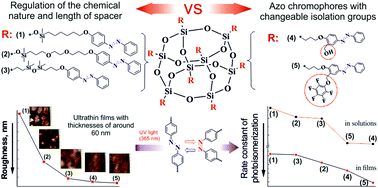Novel branched nanostructures based on polyhedral oligomeric silsesquioxanes and azobenzene dyes containing different spacers and isolation groups†
Abstract
The great interest in smart light-responsive materials has led to the development of hybrid star-shaped nanostructures combining organic azobenzene dyes with polyhedral oligomeric silsesquioxanes (Azo-POSSs). Herein we present two approaches to fabricating azo-functionalized POSS compounds with the desired characteristics: (1) the synthesis of branched Azo-POSS structures based on azo dyes possessing flexible spacers of different chemical natures and lengths between the inorganic POSS core and the azobenzene branches, and (2) an approach that was first applied to Azo-POSS systems – the synthesis of Azo-POSS conjugates with isolation groups (they minimize undesired chromophore–chromophore interactions) in the azobenzene fragments and the constant short spacer between the azo dyes and the medium. The first one was synthesized from azo dyes containing hexenyloxy-, allyloxy-ethoxypropoxy- and tetramethyl-disiloxanyl-propoxy substituents, while the second one was prepared from allyl-functionalized azo-based chromophores with changeable isolation groups (hydroxymethylene-, trimethylsiloxymethylene- and pentafluorophenoxymethylene-groups). According to DSC analysis the Azo-POSS based on the hexenyloxy-substituted dye has crystalline domains whereas all other Azo-POSS compounds are amorphous. We found that robust and ultrathin films with a thicknesses of around 60 nm and low refractive indices (ca. 1.46) can be fabricated from all Azo-POSS branched conjugates. It was demonstrated that the surface roughness of the Azo-POSS films can be significantly minimized by the attachment of azo dyes having side isolation groups into the POSS core. Moreover, for Azo-POSS molecules with isolation groups in the azobenzene units, we observed a significant decrease in the trans–cis photoisomerization rate in solution compared to other obtained star-shaped Azo-POSS systems. At the same time, the photoisomerization rates of the synthesized Azo-POSS conjugates in films are almost the same. These results indicate that the presence of the isolation groups effectively prevents inter- and intramolecular aggregation of azobenzene chromophores attached to the POSS core in the solid state.



 Please wait while we load your content...
Please wait while we load your content...